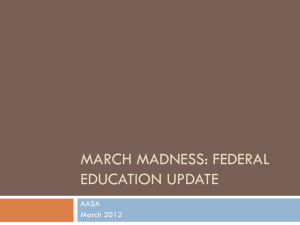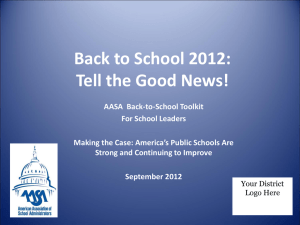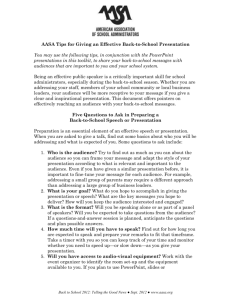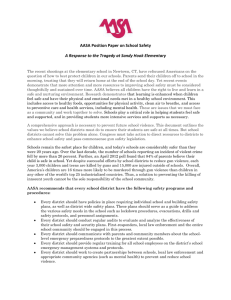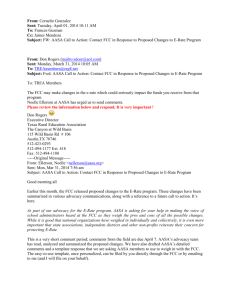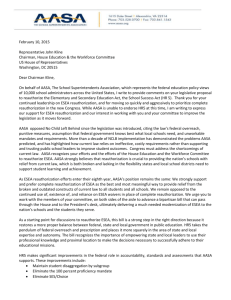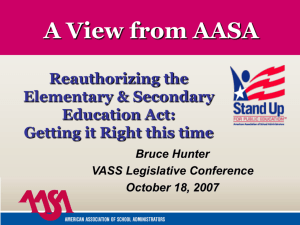AASA Position Statements
advertisement
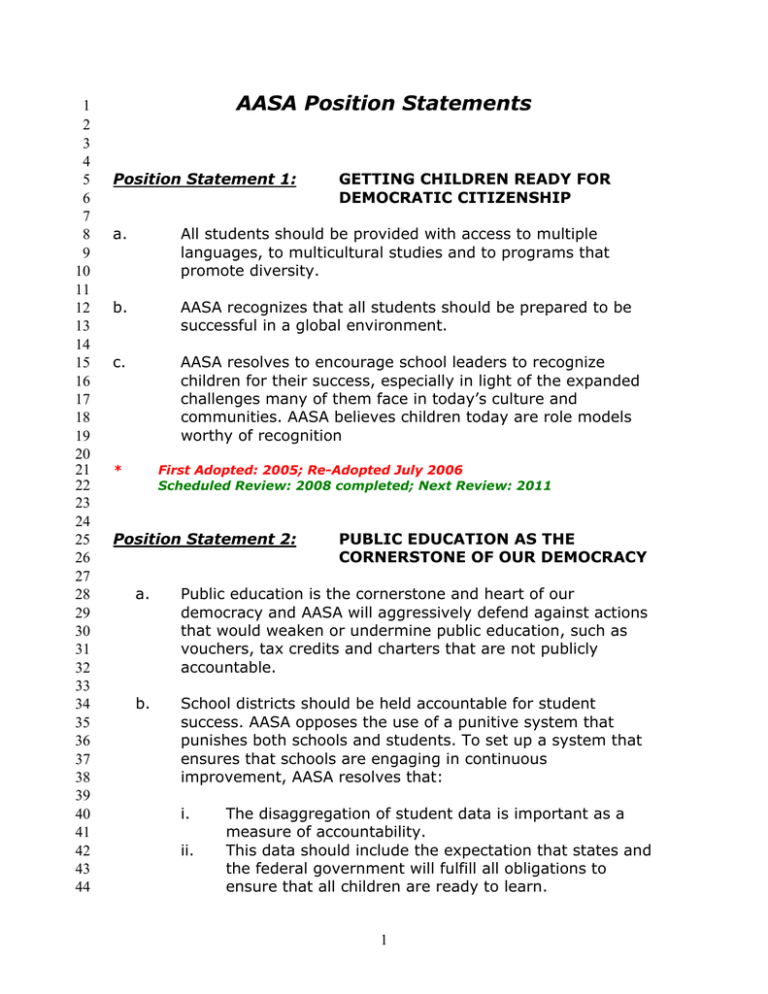
1 2 3 4 5 6 7 8 9 10 11 12 13 14 15 16 17 18 19 20 21 22 23 24 25 26 27 28 29 30 31 32 33 34 35 36 37 38 39 40 41 42 43 44 AASA Position Statements Position Statement 1: GETTING CHILDREN READY FOR DEMOCRATIC CITIZENSHIP a. All students should be provided with access to multiple languages, to multicultural studies and to programs that promote diversity. b. AASA recognizes that all students should be prepared to be successful in a global environment. c. AASA resolves to encourage school leaders to recognize children for their success, especially in light of the expanded challenges many of them face in today’s culture and communities. AASA believes children today are role models worthy of recognition * First Adopted: 2005; Re-Adopted July 2006 Scheduled Review: 2008 completed; Next Review: 2011 Position Statement 2: PUBLIC EDUCATION AS THE CORNERSTONE OF OUR DEMOCRACY a. Public education is the cornerstone and heart of our democracy and AASA will aggressively defend against actions that would weaken or undermine public education, such as vouchers, tax credits and charters that are not publicly accountable. b. School districts should be held accountable for student success. AASA opposes the use of a punitive system that punishes both schools and students. To set up a system that ensures that schools are engaging in continuous improvement, AASA resolves that: i. ii. The disaggregation of student data is important as a measure of accountability. This data should include the expectation that states and the federal government will fulfill all obligations to ensure that all children are ready to learn. 1 45 46 47 48 49 50 51 52 53 54 55 56 57 58 59 60 61 62 63 64 65 66 67 68 69 70 71 72 73 74 75 76 77 78 79 80 81 82 83 84 85 86 87 88 iii. * The application of the state and federal public school accountability systems should apply to all institutions or individuals that receive public funding to educate children. First Adopted: 2005; Re-Adopted: July 2006 Scheduled Review: 2008 completed; Next Review: 2011 Position Statement 3: GETTING CHILDREN READY FOR SUCCESS IN SCHOOL a. For children to be ready to attend school, steps must be taken to account for non-school factors that could affect student achievement. Therefore, AASA strongly supports the enactment of universal healthcare for all children. b. Recognizing the critical role that families and early education plays in getting students ready for school, AASA resolves that every child must be provided with quality, comprehensive early childhood programming so that he/she can enter kindergarten ready to learn with skills necessary to ensure success in school. c. AASA supports comprehensive services and programs that encourage children to be healthy. * First Adopted: 2005; Re-Adopted: July 2006 Scheduled Review: 2009 Position Statement 4: Licensure for Administrators Only graduate degrees, licensures or endorsements in educational administration, supervision and leadership issued by state licensing agencies through accredited colleges and universities should be recognized for the preparation, appointment and promotion of school leaders. * First Adopted: 2006; Re-Adopted: July 2006 Scheduled Review: 2009 2 89 90 91 92 93 94 95 96 97 98 99 100 101 102 103 104 105 106 107 108 109 110 111 112 113 114 115 116 117 118 119 120 121 122 123 124 125 126 127 128 129 130 131 Position Statement 5: GETTING SCHOOLS READY FOR CHILDREN a. Schools that are aligned around systems leadership will accelerate movement toward universal proficiency. Therefore, AASA resolves that school administrators should place a greater emphasis on systems leadership to meet the challenges of a global society. b. The intended focus of No Child Left Behind is laudable but the current law contains four major conceptual problems including: i. ii. iii. iv. A challenge to federalism, A flawed organizational change strategy, A flawed educational change strategy, and A failure to account for the impact of non-school factors on student achievement. AASA resolves that decision making should be made at the local level to allow local educators, who best understand the needs of their students, to make decisions and design educational programs to meet children’s needs. c. AASA resolves that all students and families must have access to the latest technology and be provided opportunities to learn and develop the intellectual skills necessary for success in our global society. d. AASA resolves that all students and families be provided a strong support system to include advocacy and advisement. * First Adopted: 2005; Re-Adopted: July 2006 Scheduled Review: 2009 Position Statement 6: INDIVIDUALS WITH DISABILITIES EDUCATION ACT (IDEA) The education of children with disabilities demonstrates a national commitment to equal educational opportunity for every child. IDEA should be fully funded at 40% of the national average per pupil expenditures (as promised in the 1997 and 2004 reauthorizations of IDEA). 3 132 133 134 135 136 137 138 139 140 141 142 143 144 145 146 147 148 149 150 151 152 153 154 155 156 157 158 159 160 161 162 163 164 165 166 167 168 169 170 171 172 173 174 175 AASA strongly supports Congress fulfilling its promise to fully fund IDEA to the 40 percent level through mandatory funding and allowing for maximum local flexibility. AASA also urges the Center for Medicare and Medicaid Services (CMMS) to reimburse districts for medical services to Medicaid eligible students. * First Adopted: 2003; Re-Adopted: July 2007 Scheduled Review: 2008 completed; Next Review: 2011 Position Statement 7: MAKING FEDERAL FUNDING FOR IDEA MANDATORY This Position Statement was consolidated into #6 in July 2008. Position Statement 8: OPPOSITION TO VOUCHERS AASA absolutely opposes undermining universal equal educational opportunity for all, supports the separation of church and state in public school funding, and opposes increasing the segregation of America's children by diverting public funds in support of vouchers and related initiatives. AASA supports the application of public school academic accountability standards and regulatory requirements to all non-public schools receiving public funds. AASA opposes local, state, and federal financial incentives that reward private corporations for supporting non-public school entities. * First Adopted: 2004; Re-Adopted: July 2007 Scheduled Review: 2010 4 176 177 178 179 180 181 182 183 184 185 186 187 188 189 190 191 192 193 194 195 196 197 198 199 200 201 202 203 204 205 206 207 208 209 210 211 212 213 214 215 216 217 218 219 220 Position Statement 9: PUBLIC SCHOOL CHOICE AND CHARTER SCHOOLS AASA supports public school choice and charter schools that operate under the auspices of local public school boards. We believe that there should be a level playing field, including non-discriminatory and unconditional enrollment for all children. Therefore, the same regulations and accountability should apply to all schools receiving public funding. How charter schools are financed must be addressed so that their creation does not have an adverse effect on the quality of existing public schools. * First Adopted: 1999; Re-Adopted: July 2007 Scheduled Review: 2009 Position Statement 10: SCHOOL FINANCE SYSTEMS FOCUSED ON PROFICIENCY FOR ALL STUDENTS AASA supports litigation and legislation in states that will result in schools where the resources match the challenge of bringing every student to a high level of achievement called proficiency. AASA supports creating a stable, equitable, and adequate funding stream for schools based on local, state and federal revenues that will meet the challenges of universal proficiency and provide the stable funding base needed to support the changes from a system focused on access to a system focused on proficiency. * First Adopted: 2004; Re-Adopted: July 2007 Scheduled Review: 2010 Position Statement 11: VOUCHERS AND TUITION TAX CREDITS AASA opposes vouchers and all forms of tuition tax credits for private or sectarian schools. We believe government financed vouchers divert funds from public schools. * First Adopted: 1999; Re-Adopted: July 2007 Scheduled Review: 2009 5 221 222 223 224 225 226 227 228 229 230 231 232 233 234 235 236 237 238 239 240 241 242 243 244 245 246 247 248 249 250 251 252 253 254 255 256 257 258 259 260 261 262 263 264 265 266 267 Position Statement 12: ADVOCATES FOR CHILDREN AASA is an advocate for the health and well-being of our nation’s children. Research demonstrates that learning is enhanced when children feel safe and have their physical and emotional needs met in a healthy school environment. This includes access to healthy foods, opportunities for physical activity, clean air to breathe, access to preventive care and health services, including mental health. * First Adopted: 2006; Re-Adopted: July 2007 Scheduled Review: 2010 Position Statement 13: APPROPRIATE EDUCATION PROGRAMS FOR ALL CHILDREN— BEGINNING AT AGE 3 A high percentage of a child’s development and learning occurs by age 5. All children should enter school ready to learn, and every adult in the community must assume a measure of responsibility for the education, welfare and safety of each child. Therefore, AASA believes that communities should offer developmentally appropriate educational programs for all children beginning at age 3. The future success of all children requires such an investment. * First Adopted: 1995; Re-Adopted: July 2007 Scheduled Review: 2010 Position Statement 14: EQUITY FOR ALL CHILDREN AASA supports educational experiences that foster a respect for diversity and an understanding of individual differences and cultures in an environment viewed by all as safe and orderly. AASA supports engaging families and community members to promote student success with programs that sustain effective collaboration. AASA promotes equity and excellence for students, educators and administrators by implementing continuous improvement and research-supported best practices. AASA advocates for policies that address the unique needs of persistently underserved and, thus, underachieving populations of poor, minority, disabled and Englishlanguage learners. AASA endorses collaboration with other educational organizations and institutions to offer learning experiences designed to promote innovation, independent initiative, leadership development and creativity. * First Adopted: 1996, 1997; Re-Adopted: July 2007 Scheduled Review: 2008 Completed; Next Review: 2011 6 268 269 270 271 272 273 274 275 276 277 278 279 280 281 282 283 284 285 286 287 288 289 290 291 292 293 294 295 296 297 298 299 300 301 302 303 304 305 306 307 308 309 310 311 312 Position Statement 15: FACILITIES AASA recognizes the important role of school facilities in creating an appropriate learning environment for all children. AASA believes that facilities must not only be conducive to learning, but must also provide a safe place to learn. * First Adopted: 1998; Re-Adopted: July 2007 Scheduled Review: 2010 Position Statement 16: LOCAL FUNDING AASA encourages and endorses the efforts of local administrators and boards of education to challenge funding systems that result in inequitable and inadequate funding. * First Adopted: 1998; Re-Adopted: July 2007 Scheduled Review: 2010 Position Statement 17: UNFUNDED MANDATES AASA strongly advocates that federal mandates such as IDEA and ESEA, as well as state mandates, be fully funded in order to establish stable and equal support for all students. Based on the literal meaning of Section 9527 (a) of No Child Left Behind, AASA supports action to obtain required funds to implement NCLB. * First Adopted: 2004; Re-Adopted: July 2007 Scheduled Review: 2008 completed; Next Review: 2011 Position Statement 18: PROVIDING SAFE AND NURTURING ENVIRONMENT FOR CHILDREN Children have a right to live in a safe and nurturing environment. Therefore, the opportunity to learn in a safe and nurturing place is a fundamental right of every child in America. Students cannot learn without it. * First Adopted: 2000; Re-Adopted: July 2007 Scheduled Review: 2009 7 313 314 315 316 317 318 319 320 321 322 323 324 325 326 327 328 329 330 331 332 333 334 335 336 337 338 339 340 341 342 343 344 345 346 347 348 349 350 351 352 353 354 355 356 357 Position Statement 19: TECHNOLOGY AASA recognizes the importance that technology must play in the education of our nation’s youth. We strongly endorse federal, state and local efforts to provide funding for the support, maintenance and upgrading of technology to enable each classroom to achieve full state-of-the-art global connectivity. * First Adopted: 1996, 1997; Re-Adopted: July 2007 Scheduled Review: 2010 Position Statement 20: STANDARDS AND ASSESSMENTS Children live in a highly mobile and globally oriented world; therefore, AASA recognizes the need for the highest standards for all children. AASA supports the establishment of standards for student performance, curriculum content, certification and professional training. The standards should include the mastery of basic skills and higher-order thinking skills. AASA supports accountability of students for these standards and the use of valid and reliable assessment programs for reporting progress to the students and the general public. * First Adopted: 1997; Re-Adopted: July 2007 Scheduled Review: 2009 Position Statement 21: SCHOOL AND DISTRICT ACCOUNTABILITY A system of accountability must clearly demonstrate the level of progress attained by schools or school districts in fulfilling their mission of increasing student achievement. The responsibility for student learning demands that measures of success include multiple indicators and timely interventions which are understood and acceptable to the many publics served by the schools, especially students and their families. * First Adopted: 2000; Re-Adopted: July 2007 Scheduled Review: 2008 completed; Next Review: 2011 8 358 359 360 361 362 363 364 365 366 367 368 369 370 371 372 373 374 375 376 377 378 379 380 381 382 383 384 385 386 387 388 389 390 Position Statement 22: 391 392 393 394 395 396 397 398 399 400 AASA recommends that ESEA move from the 93 disconnected and disjointed programs added between the original passage of the law in 1965 and the most recent reauthorization in 2001, toward a more systemic continuum of services and supports based on poverty, special student populations and special conditions. We need to return to the original goal of ESEA, which was to promote equal educational opportunity. ESEA should be revised to provide a continuum of services and support based on a continuum of need. Need should be primarily defined by eligibility for free and reduced cost meals under the federal nutrition program, but should also consider special groups of students and special circumstances for school districts. EARLY CHILDHOOD EDUCATION AASA supports efforts to increase the use of early childhood education as a way to prepare children for learning at the earliest stages. * First Adopted: 2002; Re-Adopted: July 2007 Scheduled Review: 2010 Position Statement 23: EQUITY IN ACCOUNTABILITY AASA supports application of the state public school accountability system to all who receive state funding including virtual schools, charter schools and parents who home school their children. * First Adopted: 2004; Re-Adopted: July 2007 Scheduled Review: 2009 Position Statement 24: NATIONAL TESTING AASA supports national testing, which samples student performance such as NAEP, and assessment to promote learning and provide accountability. AASA supports tests that measure improvement. We oppose the use of limited federal funds for additional federal tests, especially those that test all students at given grade levels. * First Adopted: 1998; Re-Adopted: July 2007 Scheduled Review: 2009 Position Statement 25: ELEMENTARY AND SECONDARY EDUCATION ACT (ESEA) (replaced the previous Position Statement #25 No Child Left Behind (NCLB)) 9 401 402 403 404 405 AASA believes that a high-quality public education is a basic civil right for all children. Equal access to educational opportunity is a cornerstone of American democracy. State and local school system leaders are dedicated to helping students reach high levels of learning and to preparing students to be active participants in a global society. 406 407 408 409 410 411 412 413 414 415 416 417 418 419 420 421 422 423 424 425 426 427 AASA believes the primary responsibility for determining educational methods and strategies resides at the state and local level, consistent with the 1979 U.S. Department of Education Organization Act. States have a constitutional responsibility to establish, fund and support public education. Local school districts have a responsibility to ensure student learning in the context of their state’s constitutional requirements for education. 428 429 430 431 AASA believes ESEA should provide coherent goals, assumptions and methods to improve learning for all students, especially for low-income and minority students. These goals, assumptions and methods should be based on evidence gained from research and practice. 432 433 434 435 436 437 438 439 440 441 442 443 444 * AASA believes the role of the federal government in education is to help ensure equal opportunities to learn for each child by assisting states and school districts in their efforts to develop capacity, by providing leadership and by providing resources. The federal government should supplement and support rather than dictate state efforts in education. AASA members know that the devastating effects of poverty have a significant impact on student achievement. While school systems do address the effects of poverty, they cannot eliminate the causes of poverty. Federal efforts to improve student achievement should coordinate with other relevant systems, such as health care, housing and judicial systems, to alleviate the fundamental inequities that perpetuate poverty. AASA believes that states and school systems should not be required to spend state and local funds to implement federal program mandates. First Adopted: 2008 Scheduled Review: 2011 10 445 446 447 448 449 450 451 452 453 454 455 456 457 458 459 460 461 462 463 Position Statement 26: 464 465 466 AASA supports the efforts to develop new models designed to identify, attract, hire, train, support and retain highly-qualified educators and school leaders from diverse backgrounds. 467 468 469 470 471 472 473 474 475 476 477 478 479 480 481 482 483 484 485 486 487 488 PROFESSIONAL COMPENSATION AASA supports professional compensation for superintendents and middle management members that is consistent with educational preparation, performance, position, and responsibility. * First Adopted: 1993; Re-Adopted: July 2007 Scheduled Review: 2010 Educational leaders’ effectiveness is enhanced by multi-year contracts which attract and retain high quality leadership for the public schools. * First Adopted: 1994: Re-Adopted: July 2007 Scheduled Review: 2010 Position Statement 27: * EDUCATOR SHORTAGE-RECRUITMENT AND RETENTION First Adopted: 2000; Re-Adopted: July 2007 Scheduled Review: 2008 completed; Next Review: 2011 Position Statement 28: HEALTH & WELLNESS The members of the American Association of School Administrators (AASA) are the leaders of the nation’s schools and should model behaviors that are important to the health and wellness of their students, staff, and communities. * First Adopted: 1996, 1997; Re-Adopted: July 2007 Scheduled Review: 2010 11 489 490 491 492 493 494 495 496 497 498 499 500 501 502 503 504 505 506 507 508 509 510 511 512 513 514 515 516 517 518 519 520 521 522 523 524 525 526 527 528 529 530 531 532 533 Position Statement 29: PERSONNEL SHORTAGES AASA recognizes the impact of critical personnel shortages on the quality of educational programs and services in America’s public schools. Attracting and retaining properly certified classroom teachers, school administrators and central office administrators, including school superintendents, should become a primary goal for all stakeholders including our professional organizations, our state legislators, the federal government and the business community. AASA also recognizes that without comprehensive intervention by all of these stakeholders, the emerging shortage will continue to be a crisis in public education. AASA supports the adoption and use of the National Board for Professional Teaching Standards and the Interstate School Leaders Licensure Consortium (ISLLC) as national standards for school personnel and endorsement of these standards as a “national passport.” * First Adopted: 2002; Re-Adopted: July 2007 Scheduled Review: 2009 Position Statement 30: PORTABILITY OF PROFESSIONAL CREDENTIALS AND PENSIONS AASA supports pension portability and licensure reciprocity because the free flow of professional leadership is necessary for all school systems to deliver on the new mission of universal proficiency. Every state ought to provide educators with a means to transfer from state to state with experience, licensure and pension plan intact. AASA supports complete mobility within public education for educators and their families through the creation of national initiatives that ease the movement between states. AASA supports states’ rights to establish compensation terms that align to the unique socio-economic conditions of the respective states. * First Adopted: 2004: Re-Adopted: July 2007 Scheduled Review: 2010 12 534 535 536 537 538 539 540 541 542 543 544 545 546 547 548 549 550 551 552 553 554 555 556 557 558 559 560 561 562 563 564 565 566 567 568 569 570 571 572 573 574 575 576 577 578 Position Statement 31: PROFESSIONAL DEVELOPMENT Effective professional development programs for school administrators lead to educational improvement at all levels. AASA encourages a systemic and coordinated effort among state education agencies and other professional organizations to support professional development programs designed to improve the knowledge and skills of teachers, administrators, and others. * First Adopted: 2006: Re-Adopted: July 2007 Scheduled Review: 2010 Position Statement 32: TEACHER SHORTAGES Attracting and retaining properly certified classroom teachers is a primary goal for all stakeholders including our professional organizations, our state legislators, the federal government and the business community. AASA supports efforts to increase high-quality alternative certification programs and to provide tax credits for teachers and principals as incentive to enter high-poverty and lowperforming schools. * First Adopted: 2003; Re-Adopted: July 2007 Scheduled Review: 2010 Position Statement 33: COMMUNITY COLLABORATION AND PARTNERSHIPS Communities are responsible for the health, safety and education of each child. Schools are but one partner in the arena of public and private agencies. AASA urges and supports collaborative, community-wide programs and the delivery of full service programs to address the needs of all children. * First Adopted: 1994: Re-Adopted: July 2007 Scheduled Review: 2009 13 579 580 581 582 583 584 585 586 587 588 589 590 591 592 593 594 595 596 597 598 599 600 601 602 603 604 605 606 607 608 609 610 611 612 613 614 615 616 617 618 619 620 621 622 623 Position Statement 34: COLLABORATION AMONG YOUTH SERVICES AASA supports quality community-wide programs and services designed to break the cycle of poverty and address the readiness needs of all children. * First Adopted: 1993; Re-Adopted: July 2007 Scheduled Review: 2009 Position Statement 35: COMMUNICATING EFFECTIVELY WITH THE PUBLIC The future of public education depends on effective communication and relationship building. Developing long-term relationships with staff and community based on regular, honest, and open communication helps build understanding of, advocacy for, and commitment to the mission of the school district. * First Adopted: 2006; Re-Adopted: July 2007 Scheduled Review: 2009 Position Statement 36: LEAVING DECISIONS REGARDING COMMERCIAL AFFILIATIONS WITH LOCAL SCHOOL DISTRICTS AASA supports leaving decisions on commercial affiliations to school districts with local boards of education and opposes state and federal legislation to limit such arrangements. AASA urges local school boards to protect student health and wellbeing when establishing commercial partnerships and exclusive sales agreements. * First Adopted: 2004; Re-Adopted: July 2007 Scheduled Review: 2010 14 624 625 626 627 628 629 630 631 632 633 634 635 636 637 638 639 640 641 642 643 644 645 646 647 648 649 650 651 652 653 654 655 656 657 658 659 660 661 662 663 664 665 666 667 668 669 670 671 672 Position Statement 37: LEADERSHIP DEVELOPMENT AASA supports professional development for superintendents and boards, standards to hold both administrators and their boards accountable, and financial incentives to encourage individuals to enter educational administration. * First Adopted: 2002; Re-Adopted: July 2007 Scheduled Review: 2009 Position Statement 38: HIGH SCHOOL IMPROVEMENT AASA should consider these elements of high school improvement: * • All high school improvement must be rooted in the larger context of Pre K -16 programming. • High schools should be judged by the number of students who graduate, with flexibility to allow more time for those students who need it. There must be an accurate data system that provides a common definition of dropouts and includes the flexibility to translate graduation rates in three, four, five, or six years, similar to data collected for college graduation. • Improvement efforts should focus on high-quality curriculum that is thorough, rigorous, robust, and relevant to the real world. Equally important is a focus on the relationships among students and between students and adults in the school. Indicators of success should not be limited to state assessments. • High schools should develop strategies for teaching literacy, which includes reading and writing across content areas. • Schools should identify and address the varying needs of students as they transition into and out of high school. Programming at these junctions should reflect learning beyond minimum standards. First Adopted: 2007 Scheduled Review: 2008 Completed; Next Review: 2011 15 673 674 675 676 677 678 679 680 681 682 683 684 685 686 687 688 689 690 691 692 693 694 695 696 697 698 699 700 701 702 703 704 705 706 707 Position Statement 39: INTEGRATION TO CORRECT RACIAL AND ECONOMIC ISOLATION IN SCHOOLS AASA believes schools and school districts which correct racial and economic isolation provide the best preparation for participation in America’s multiethnic society and the global society for which we are educating children. School administrators have a moral and ethical responsibility to provide affirmative leadership and to advocate for integrated, high- quality schools. School leaders must work with other organizations and agencies to establish open, affordable housing, equal employment opportunities, economic security and full social participation. We encourage local superintendents to develop solutions that achieve the goal of an integrated society, and we also encourage nonpublic school administrators to diversify the student population of their schools. * First Adopted: 2008 Scheduled Review: 2008 Position Statement #40: Public Education is a Civil Right Public education is the cornerstone and heart of our democracy. Without a viable and effective public education system, the citizens of the United States will not be able to exercise the rights granted to them by the Constitution of the United States. Every student has a right to be educated and that right cannot be infringed by race, religion, ethnicity, disability, economic status or any other factor. Therefore, AASA believes that Public Education is a Civil Right. * First Adopted: 2008 Scheduled Review: 2011 16
